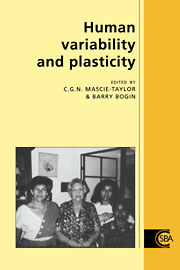Book contents
- Frontmatter
- Contents
- List of contributors
- Foreword
- 1 The pervasiveness of plasticity
- 2 Plasticity in early development
- 3 Plasticity in the growth of Mayan refugee children living in the United States
- 4 The place of plasticity in the study of the secular trend for male stature: an analysis of Danish biological population history
- 5 Plasticity, growth and energy balance
- 6 The study of migrants as a strategy for understanding human biological plasticity
- 7 Human migration: effects on people, effects on populations
- 8 The use of surnames in the study of human variation and plasticity
- 9 A biological anthropological approach to measuring societal stress of parasitic disease: a case study of schistosomiasis
- 10 Biological adaptability, plasticity and disease: patterns in modernizing societies
- 11 Human biological adaptability with special emphasis on plasticity: history, development and problems for future research
- Index
3 - Plasticity in the growth of Mayan refugee children living in the United States
Published online by Cambridge University Press: 28 October 2009
- Frontmatter
- Contents
- List of contributors
- Foreword
- 1 The pervasiveness of plasticity
- 2 Plasticity in early development
- 3 Plasticity in the growth of Mayan refugee children living in the United States
- 4 The place of plasticity in the study of the secular trend for male stature: an analysis of Danish biological population history
- 5 Plasticity, growth and energy balance
- 6 The study of migrants as a strategy for understanding human biological plasticity
- 7 Human migration: effects on people, effects on populations
- 8 The use of surnames in the study of human variation and plasticity
- 9 A biological anthropological approach to measuring societal stress of parasitic disease: a case study of schistosomiasis
- 10 Biological adaptability, plasticity and disease: patterns in modernizing societies
- 11 Human biological adaptability with special emphasis on plasticity: history, development and problems for future research
- Index
Summary
Summary
The present-day Maya of Guatemala are characterized ethnically by many biocultural features. One is short stature. It is sometimes asserted that Mayans are ‘genetically short’ owing to generations of adaptation to an environment of poor health and nutrition. Alternatively, populations like the Maya are described as ‘small but healthy’. These notions imply that no amount of intervention or economic development is needed for the Maya. Recent migration of Mayan refugees to the United States affords the opportunity to study the consequences of life in a new environment on the growth of Mayan children. The results of this research show that the notions of ‘genetic shortness’ and ‘small but healthy’ for Mayans are incorrect, and that an improved environment for health and nutrition leads to increased growth.
The children of this study live in Indiantown, Florida, and Los Angeles, California. Mayan children between 4 and 12 years old (n = 240) were measured for height, weight, fatness, and muscularity. Overall, compared with reference data for the United States, the Mayan children are, on average, healthy and well-nourished. They are taller, heavier, and carry more fat and muscle mass than Mayan children living in a village in Guatemala. However, they are shorter, on average, than children of Black, Mexican-American, and White ethnicity living in Indiantown.
These findings are typical of migrant adaptation to new environments as described by Boas in 1912 and elaborated into a formal model of human biological plasticity by Lasker in 1969. Lasker's model does not clearly differentiate between plasticity that is the result of a change in the environment and plasticity that leads to a new adaptive state.
- Type
- Chapter
- Information
- Human Variability and Plasticity , pp. 46 - 74Publisher: Cambridge University PressPrint publication year: 1995
- 12
- Cited by



